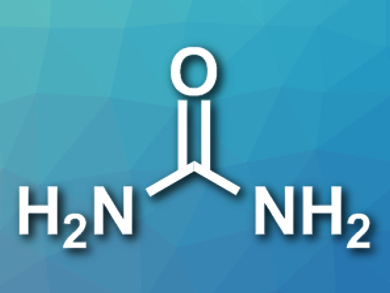Important Nitrogen Fertilizer
Urea is a seemingly simple organic compound. A carbonyl group flanked by two amino groups to make an amide, sometimes known as carbamide. It is, of course, the main nitrogen-containing compound in urine, and until Friedrich Wöhler’s discovery in 1828 that he could synthesize it from inorganic starting materials, we held it with an almost alchemist reverence as being organic and so carrying with it the vital spark. It was in that moment that chemists gained an understanding that organic compounds, while special because many are made by living things, they are not so different from inorganic compounds.
Nevertheless, urea retains something of the vital spark as a key component of agricultural food production. Of all the solid nitrogen fertilizers, urea has the highest nitrogen content per unit and so the lowest transportation cost per nitrogen nutrient unit. Almost 200 million tonnes of urea are manufactured annually and 90 % of that is used in fertilizers. However, despite the compound’s simplicity and high nitrogen content, there is an ongoing need to improve storage, transport, and application.
Crystallizing Benefits
Christer B. Aakeröy and colleagues, Kansas State University, Manhattan, USA, explain that urea’s unique place in the history of chemistry does nothing to offset two problems that face farmers in its use as an agricultural fertilizer—it is highly soluble in water in the ambient temperature range of 20–40 °C (about 110–170 g/100 mL in that range) and in solid form it is very hygroscopic, taking up moisture rapidly.
Both of these physical properties make urea as a fertilizer particularly susceptible to mobility and runoff. Farmers thus tend to use more than they really need to in order to compensate for losses. This makes the use of urea sub-optimal in terms of efficiency and waste. The excessive use of nitrogen compounds which are not taken up by crops also means that the concentration of nitrogen in the environment is raised unnecessarily, which can negatively impact air and water quality, biodiversity, and even human and animal health. In addition, because urea has a high moisture content in humid conditions (40–50 % humidity) it becomes sticky, which also leads to storage and stability problems.
Solving a Sticky Problem
While slow-release fertilizers have been developed, they come with their own issues of additional manufacturing costs and irregular nutrient release. Aakeröy and colleagues hope to remedy this situation and find a way around problems associated with this potent nitrogen fertilizer.
The team has used full interaction maps (FIMs) and data from the Cambridge Structural Database (CSD) to explore the landscape of solid forms of urea. Their aim is to navigate the many different crystalline forms that might exist and to home in on ones that can be synthesized as co-crystals of urea with reduced aqueous solubility and lower hygroscopicity than the parent compound. The team has investigated 60 co-crystal syntheses and found that 49 of them produce co-crystals, one of which has a solubility twenty times lower than urea and another one with some sixty times lower solubility. This, the team explains, makes both co-crystals, urea:pimelic acid (U2:PA) and urea:4-nitrophenol (U:4NP) less susceptible to humidity problems and endows them with better properties in terms of slow release following application in the field.
Substantial Improvements
The researchers suggest that their findings allow solid forms of urea to be changed considerably, thereby substantially improving the compound’s physicochemical properties to the benefit of agriculture. The same approach, co-crystal technologies, could also be used to overcome solubility, delivery, and stability problems associated with other agrochemicals including herbicides, pesticides, and insecticides, the team suggests. This could have a positive impact on efficiency and reduce the environmental impact of such products.
“The next phase will first be to examine whether the co-crystals with improved physical properties can be administered to plants without negatively impacting soil chemistry and plant growth in general and secondly to identify new co-formers that can deliver essential micro-nutrients to plants whilst also providing a handle for ‘dialing-in’ physical properties in a predictable manner,” Aakeröy told ChemViews Magazine.
- Modulating the physical properties of solid forms of urea using co-crystallization technology,
Bhupinder Sandhu, Abhijeet S. Sinha, John Desper, Christer B. Aakeröy,
Chem. Commun. 2018.
https://doi.org/10.1039/c8cc01144c




